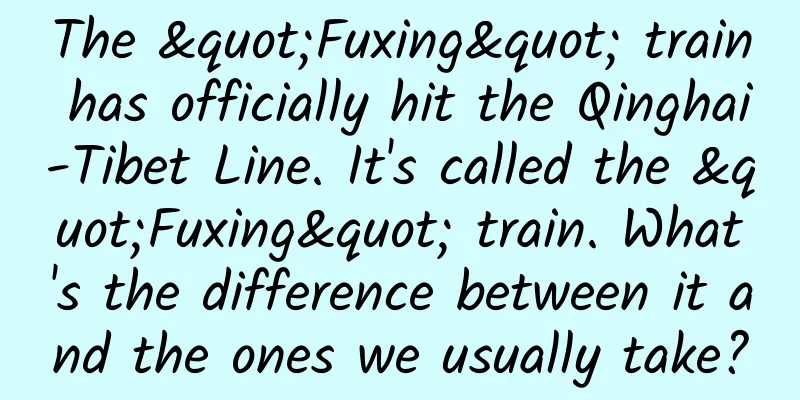The "Fuxing" train has officially hit the Qinghai-Tibet Line. It's called the "Fuxing" train. What's the difference between it and the ones we usually take?

|
According to Xinhua News Agency, the Fuxing bullet train officially started operation on the Xigolmud section (Xining-Golmud) of the Qinghai-Tibet Railway on July 1. After the Fuxing EMU is put into operation, the train speed of the Xige section of the Qinghai-Tibet Railway will be increased from the original 120 kilometers per hour to 160 kilometers per hour. The 829.251-kilometer journey will be shortened to less than 5.2 hours, and the shortest is 4.8 hours, which is nearly 2 hours shorter than the current fastest train's 6.8 hours. It can be said that this is a milestone event in the construction and operation history of the Qinghai-Tibet Railway. (At 7:00 on June 23, the Fuxing EMU on the Xige section of the Qinghai-Tibet Railway began trial operation. Image source: Xinhua News Agency) In fact, this is not the first time that the Fuxing train has been operated on the roof of the world. As early as June 25, 2021, the electrified railway from Lhasa to Linzhi was opened, and the Fuxing train had already entered the Qinghai-Tibet Plateau. Subsequently, in order to meet the growing demand, increase transportation capacity and improve passenger experience, the Xining to Golmud section of the Qinghai-Tibet Railway also launched a comprehensive speed-up renovation project, which led to the incident mentioned at the beginning of our article. 1. What is the difference between the "Fuxing" trains running on the Qinghai-Tibet Railway and the ones we usually take? There is a lot of preparation work behind the running of Fuxing EMU on the Qinghai-Tibet Railway, which involves speed-up renovation of the entire Xining to Golmud section. The main project contents include renovation of saline soil, sand-damaged and frost-damaged roadbeds; upgrading and reinforcing railway tracks and bridges; upgrading and renovation of signal systems; adding EMU maintenance bases; upgrading and renovation of railway electrification; upgrading of passenger service information systems; extension of station arrival and departure lines and renovation of station buildings, etc. The Fuxing EMU that debuted on the Qinghai-Tibet Railway for the first time is also different from the high-speed trains we usually take. It is a power-concentrated EMU tailored for the Qinghai-Tibet Railway with a maximum operating speed of 160km/h and 9 carriages. It is an upgraded product of the EMU we commonly call the "Green Giant". (The Fuxing EMU began trial operation on the Xige section of the Qinghai-Tibet Railway on June 23. Image source: CCTV News screenshot) The electrical system of the Qinghai-Tibet Railway Fuxing EMU adopts plateau adaptability technology, and the electrical insulation performance has been improved. The equipment of each voltage level of the vehicle is selected and arranged according to relevant standards to adapt to the plateau environment and improve the reliability of the system. The heat dissipation performance of the electrical components in the passenger car has been optimized. Through reasonable device arrangement and wiring, the ventilation area is increased to improve the heat dissipation effect of the components. In addition, the EMU has also carried out electrical lightning protection design such as lightning protection and grounding measures to ensure the safe operation of the train. As we all know, the Qinghai-Tibet Plateau is at a high altitude and has thin air, so ultraviolet rays are particularly strong. In order to improve the anti-ultraviolet performance, the Fuxing EMU has adopted a variety of technical measures. The driver's cab windows use tempered safety anti-shatter and PVB laminated glass, which can effectively block 99% of ultraviolet rays. The windows of the passenger car use roller curtains with high ultraviolet protection performance. At the same time, rubber parts such as window rubber are made of materials with ultraviolet resistance, and have undergone aging resistance tests to improve ultraviolet resistance. For the trailer bogie, by adding an air spring protective cover, direct exposure to ultraviolet rays on the plateau is effectively blocked. In terms of environmental performance, the Fuxing EMU has also made improvements. In order to avoid the impact of sewage discharge on the plateau environment, the EMU is equipped with a sewage collection device to centrally collect and discharge sewage from toilets, washrooms, tea rooms and dining bar areas, achieving zero emissions in the plateau area. To improve the riding comfort of passengers, Fuxing EMUs have undergone a number of technical improvements. The use of distributed and diffuse oxygen supply systems can increase the oxygen concentration in the passenger compartment to a level that is suitable for the plateau environment. The noise of the passenger car is also effectively controlled by adopting measures such as multi-layer sound insulation structure, heat insulation materials and sound insulation pads. The air conditioning system and door seals have also been optimized to reduce noise levels. At the same time, the air conditioning and heating systems have also been upgraded to meet the cooling and heating needs of the plateau environment. In addition, the integrated design of pressure wave protection of the entire train can provide a comfortable riding environment. In order to adapt to the low-pressure environment of the plateau, the EMU has carried out an airtight design for the passenger cars, and adopted sealing measures such as weld sealing, pipeline caulking and door sealing to improve the comfort inside the car. After talking about the speed increase and upgrade of the Xige section of the Qinghai-Tibet Railway, let’s talk about some interesting knowledge behind high-speed rail and EMUs. (ii) As the saying goes, a train's speed depends on the locomotive. Is the high-speed train "Fuxing" also pulled by the locomotive? In fact, "the speed of a train depends entirely on the locomotive" is aimed at the "locomotive + vehicle" operation mode of conventional railways. In this mode, the locomotive provides power and transmits the force to the vehicle through the traction device to propel the train. This "locomotive + vehicle" traction mode is a temporary combination. Once the locomotive and vehicle have completed their operational tasks at the destination, they will be separated and sent to the locomotive depot and vehicle depot for maintenance and storage. The "Fuxing" high-speed train is a high-speed EMU train developed by China, also known as the "China Standard EMU". Unlike traditional trains, high-speed trains are a whole train composed of multiple car units. In principle, a EMU is indivisible. Carriage units are divided into EMUs and trailers. EMUs refer to cars that can provide traction power, and trailers refer to cars without traction power. The car units including the driver's cabs at both ends are linked together to form an EMU, which is generally composed of 8 and 16 cars. Therefore, high-speed trains not only rely on the power of the front locomotive, but also can provide traction power through the coordinated work of the middle EMU (power distribution mode). Of course, some foreign high-speed EMUs also adopt a mode that relies solely on the front locomotive to provide power (power concentration mode). So, what are the advantages and disadvantages of centralized power and distributed power high-speed trains? 1. Centralized Power Features: The power system of the power-centralized EMU is mainly concentrated in a part of the train carriages (usually the two end carriages), which are called power cars. These power cars provide traction and driving force, while non-power cars do not have independent power devices. Advantages: The equipment layout is relatively simple, maintenance and operation are relatively easy, and it can provide a larger passenger capacity. Disadvantages: Power is concentrated in a specific car, increasing the risk of single point failure. The weight of the power car is large, resulting in higher wheel wear and energy consumption. Uneven distribution of traction during acceleration and braking. 2. Distributed Power Features: The power-distributed EMU distributes the power system in multiple carriages of the train, each of which is equipped with an independent power device. The carriages work together through electrical or mechanical connections. Advantages: The power distribution mode improves the traction and acceleration performance of the train. The failure of a single carriage will not have a serious impact on the operation of the entire train. The traction during acceleration and braking is more evenly distributed. Disadvantages: There are many power devices in the vehicle, the vehicle layout is relatively complex, and maintenance and operation are relatively cumbersome. More energy supply and power control systems are required. The centralized power type is generally suitable for medium and short-distance passenger transport, with a larger passenger capacity and a relatively simplified vehicle design. The decentralized power type is suitable for long-distance high-speed transportation, with better acceleration performance and operating stability, but requires more complex vehicle configuration and maintenance. (3) What is the difference between what we usually call “high-speed rail” and “EMU”? High-speed rail and EMU are two related but different concepts, and many readers often confuse them. High-Speed Rail generally refers to a railway system with a higher design speed (usually greater than 250 km/h) and strict technical standards, including dedicated high-speed railway lines, high-performance EMUs, high-standard vehicles and track technology, etc. EMU (Electric Multiple Units) is the abbreviation of "EMU", which refers to EMUs with centralized or decentralized power. EMUs can run on different railway systems, and their operating speeds can vary depending on the specific design and conditions of use. Some EMUs can run at very high speeds, but some EMUs are used on ordinary railways, so their operating speeds are usually lower. In my country, many people refer to G-prefixed trains as high-speed trains. In fact, they are both EMUs, just like D-prefixed trains. Using high-speed trains as a synonym for EMUs is an irregular term, and readers need to distinguish them. 4. Most high-speed rail lines are newly built. So can ordinary railways be upgraded to high-speed rail? In principle, ordinary railways can be upgraded and transformed into high-speed rail lines, but the transformation process is a complex and challenging task, requiring upgrades in many aspects from line standards to track quality and signal systems. This not only requires huge amounts of money, but also comes at a great cost. Through economic and technical comparisons, the cost-effectiveness is not necessarily high, so high-speed railways with speeds of 200-350k/h are generally newly built lines. Of course, if conventional railways only upgrade and transform EMUs with low running speeds, that is another matter. For example, the transformation of the Xining to Golmud section of the Qinghai-Tibet Railway is a realistic and feasible case. So, what are the main projects involved in upgrading conventional railways to high-speed railways? 1. Improve line standards High-speed rail needs to meet higher technical standards, including stricter track geometry, more flexible line slopes, larger curve radii, wider railway tunnels, stronger bridges, more reliable signal and train control systems, etc. Therefore, it is necessary to upgrade the existing ordinary railways to meet the requirements of high-speed rail, which will involve geological surveys, civil engineering and line optimization. 2. Improve track quality High-speed train operation requires a higher-quality track system, including track flatness, track verticality, and track geometry. If the tracks on ordinary railways are to meet the requirements of high-speed trains, it may involve replacing track materials, improving track maintenance levels, and track detection technology, which is a huge project. 3. Signal and communication system upgrade High-speed trains require higher-level signal and communication systems to ensure the safety and efficiency of train operation. The signal systems on ordinary railways need to be upgraded and renovated, including the use of advanced train control systems, signal equipment and communication networks. 4. Electrification transformation High-speed trains usually use a higher level of electric traction system, so ordinary railways need to be electrified to provide power supply systems and equipment suitable for high-speed rail operation. This may involve the installation of electrification equipment, the transformation of power supply lines, etc. 5. Vehicle renewal and technology upgrade The upgrading of ordinary railways to high-speed railway lines also requires the installation of high-speed EMU trains, which means the introduction of new train vehicles with high-speed performance and technical features that meet the requirements of high-speed railway lines. 5. Why do most high-speed trains not run at night? (Copyrighted images from the gallery, unauthorized reproduction, please contact the original author) There are many reasons why most high-speed trains do not run at night, mainly including the following: 1. Safety considerations Visibility is poor at night, especially in areas without good lighting, and trains running at high speeds may face higher safety risks. Running during the day can provide better visibility and reduce the probability of accidents. 2. Maintenance and repair Nighttime is usually the main time period for railway maintenance and overhaul. By stopping high-speed trains at night, railway operating departments have more time to conduct line inspections, equipment maintenance and repair work to ensure the safety and reliability of trains during daytime operation. 3. Reduce noise and environmental impact High-speed trains may generate noise and vibration at high speeds, causing disturbance to surrounding residents and the environment. Stopping high-speed trains at night can reduce noise disturbance to residents and protect their rest and quality of life. 4. Personnel arrangement and dispatch The operation of high-speed trains requires a large number of staff, including train drivers, crew members, maintenance personnel, etc. Night operation may require additional staff scheduling and arrangements, increasing operating costs and management difficulties. 5. Load Balancing The daytime is usually the time when passengers have a high demand for travel, and high-speed trains running during the day can better meet passengers' travel needs. However, passenger demand is lower at night, and running high-speed trains at night may lead to unbalanced train loads and low economic benefits. It is important to note that not all high-speed rail lines do not operate at night. Some high-speed rail lines may operate limited train services at certain times of the night to meet the needs of some night-time passengers. This usually occurs during specific peak passenger flow periods or special circumstances, such as holiday traffic peaks. Produced by : Science Popularization China Author : Wang Lin, senior railway engineer, member of China Science Writers Association, director of Tianjin Science Writers Association Produced by : China Science and Technology Press Co., Ltd., China Science and Technology Publishing House (Beijing) Digital Media Co., Ltd. |
<<: What's going on with the golden monkeys in Yunnan, Guizhou and Sichuan?
>>: Can we eat such delicious braised pork in a healthier way?
Recommend
Intel Launches New SoC Solution to Dramatically Reduce Costs and Accelerate Electric Vehicle Innovation
Innovative OLEA U310 SoC simplifies motor technol...
Analysis of Tik Tok’s refined operation and promotion techniques!
The author of this article analyzes Douyin’s pers...
Alibaba's stock price hits new highs: there are bright spots and crises behind it
Last night, Alibaba's stock price climbed abo...
Douyu live broadcast market and user analysis!
Due to the epidemic in the first half of this yea...
GP Bullhound: Technology Forecast Report 2025
Technology Predictions for 2025 Multimodal artifi...
The Ultimate 7-Step Method for Planning a Promotional Plan
I have heard many of my friends and colleagues ta...
Product News | What are the recent important updates of Baidu Promotion?
Commercial products are updated quickly...How can...
Baidu Smart Mini Programs are a new traffic hotspot
What is Baidu Smart Mini Program? Baidu Smart Min...
Why did Zhou Hongyi return to the mobile phone market?
Zhou Hongyi was willful yesterday and spent $400 ...
Put everything in the refrigerator? Be careful, it will go bad faster!
Lock the refrigerator to keep it fresh | Tuchong ...
C4D tutorial 105 episodes
This set of C4D example tutorials has a total of ...
Lei Jun's interview with the audience: Xiaomi's boundaries, vision and challenges
December 17 was the day after Lei Jun’s 45th birt...
VisionMobile: IoT Developer Program Best Practices Survey (Infographic)
199IT original compilation Developers value the c...
Budget account, how to set the daily budget for Baidu promotion account?
The detailed explanation of the daily budget of B...
The innocent-looking little white flower is actually a hidden "plant bulldozer"
I believe that everyone has seen this kind of whi...









